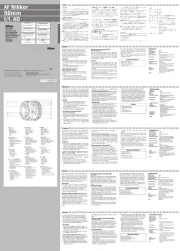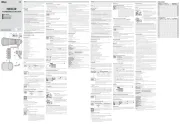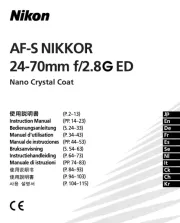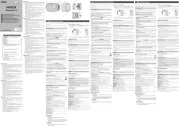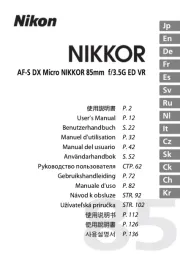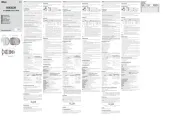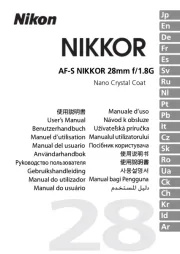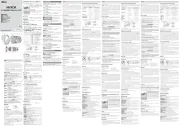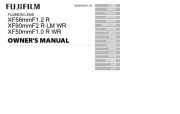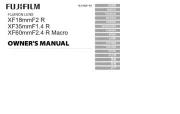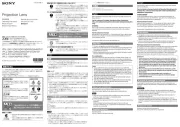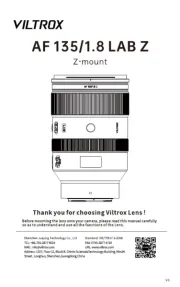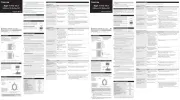中文版(简体)
Printed in Japan
SB5C02(27)
8MNJC625-02
Sc
使用说明书
随附配件
62mm搭扣式镜头前盖
镜头后盖
AF Micro-Nikkor 60 mm f/2.8D
En
User’s Manual
Supplied Accessories
Supplied Accessories
Supplied Accessories
Supplied AccessoriesSupplied AccessoriesSupplied Accessories
62 mm snap-on front lens cap
Rear lens cap
感谢您选购尼康产品。该款轻巧精密的AF微距尼克尔
60 mm f /2.8D 微距镜头支持0.219m的最近对焦距离,且
可为照相机机身提供距离信息以进行即时3D矩阵测光或
3D多传感器均衡补充闪光的闪光控制。在使用本产品前,
请仔细阅读这些指南和照相机说明书,以便您在现在和今
后都能充分利用您的镜头。
使用产品前请仔细阅读本使用说明书。
安全须知
请在使用前仔细阅读“安全须知”,并以正确的方法使用。
本“安全须知”中记载了重要的内容,可使您能够安全、正
确地使用产品,并预防对您或他人造成人身伤害或财产损
失。请在阅读之后妥善保管,以便本产品的所有使用者可以
随时查阅。
有关指示
本节中标注的指示和含义如下。
A警告 表示若不遵守该项指示或操作不当,则有可
能造成人员死亡或负重伤的内容。
A注意
表示若不遵守该项指示或操作不当,则有可
能造成人员伤害、以及有可能造成物品损害
的内容。
本节使用以下图示和符号对必须遵守的内容作分类和说明。
图示和符号的实例
I
L符号表示唤起注意(包括警告)的内容。
在图示中或图示附近标有具体的注意内容(左图之
例为当心触电)。
E
F符号表示禁止(不允许进行的)的行为。
在图示中或图示附近标有具体的禁止内容(左图之
例为禁止拆解)。
K
D符号表示强制执行(必需进行)的行为。
在图示中或图示附近标有具体的强制执行内容(左
图之例为取出电池)。
A警告
E禁止拆解
切勿自行拆解、修理或改装。
否则将会造成触电、发生故障并导致受
伤。
G
C
禁止触碰
立即委托
修理
当产品由于跌落而破损使得内部外露时,
切勿用手触碰外露部分。
否则将会造成触电、或由于破损部分而导
致受伤。取出照相机电池,并委托经销商
或尼康授权的维修服务中心进行修理。
K
C
取出电池
立即委托
修理
当发现产品变热、冒烟或发出焦味等异常时,
请立刻取出照相机电池。
若在此情况下继续使用,将会导致火灾或
灼伤。取出电池时,请小心勿被烫伤。取出
电池,并委托经销商或尼康授权的维修服
务中心进行修理。
J禁止
接触水
切勿浸入水中或接触到水,或被雨水淋
湿。
否则将会导致起火或触电。
F禁止使用
切勿在有可能起火、爆炸的场所使用。
在有丙烷气、汽油、可燃性喷雾剂等易燃
性气体、粉尘的场所使用产品,将会导致
爆炸或火灾。
F禁止观看
切勿用镜头或照相机直接观看太阳或强
光。
否则将会导致失明或视觉损伤。
A注意
I当心触电 切勿用湿手触碰。
否则将有可能导致触电。
F禁止放置 切勿在婴幼儿伸手可及之处保管产品。
否则将有可能导致受伤。
A小心使用
进行逆光拍摄时,务必使太阳充分偏离视
角。
阳光会在照相机内部聚焦,并有可能导致
火灾。
太阳偏离视角的距离微小时,也有可能会导
致火灾。
A妥善保存
不使用时请盖上镜头盖,或保存在没有阳
光照射处。
阳光会聚焦,并有可能导致火灾。
A小心移动
进行移动时,切勿将照相机或镜头安装在
三脚架上。
摔倒、碰撞时将有可能导致受伤。
F禁止放置
切勿放置于封闭的车辆中、直射阳光下或
其它异常高温之处。
否则将对内部零件造成不良影响,并导致
火灾。
■
镜头部件
q
测光耦合脊
w CPU接点
e
光圈传递杆
r
光圈刻度
t
光圈直读刻度
y
光圈环
u
光圈 /镜头安装标记
i
对焦限制切换器
o
对焦距离指示窗口
!0 A-M模式环释放按钮
!1 EE伺服耦合杆
!2
最小光圈锁定杆
!3
镜头镜筒
!4 A-M模式标记
!5
对焦环
!6 A-M模式环
!7
复制比率指示
!8
对焦距离指示
!9
景深指示
@0
对焦距离标记
■
注意事项
• 请保持 CPU镜头接点清洁并小心不要损坏CPU接点。
• 不要将以下配件直接安装至本镜头:
PK-1或PK-11自动延
伸环、
BR-4或BR-2自动环、K1或K2环(
PK-11
A和BR-2A
可分别代替 PK-11和BR-2使用)。若不遵守此注意事项,可
能会导致损坏本镜头的CPU 接点或其他部件。其他镜头
配件可能与照相机不兼容;请务必在使用前先查阅照相
机的说明书。
• 在某些照相机上,当光圈锁定于最小值时无法安装镜头。
安装镜头前务必先解除光圈锁定。有关详细信息,请参阅
“最小光圈锁定杆”。
• 本镜头无法与用于尼康 F3AF照相机的 DX-1取景器一起
使用。
■
对焦
本镜头支持A-M 模式选择。若要选择A-M 模式,请按住
A-M 模式环释放按钮并同时旋转 A-M模式环。选择A可
进行自动对焦,选择 M则可进行手动对焦。近摄镜片镜头
不支持自动对焦 ;使用近摄镜片镜头时请选择 M
。请注意,
在镜头安装于尼康F-501时选择M将可能引起照相机故障。
■
对焦限制切换器
将对焦限制切换器从FULL滑至LIMIT 可获得更快的对焦。
对焦距离较近时,选择 LIMIT 可将对焦限制在约0.3m 至
0.219m的距离内,而对焦距离较远时,选择 LIMIT则可将
对焦限制在约0.3m至∞之间的位置。
■
复制比率
复制比率是指物体的显示大小与其实际大小的比值。例
如,若胶卷(图像传感器)上的图像为实际尺寸的 1/5,
复制比率即为1:
5。若有需要,您可使用复制比率指示
选择复制比率。例如,若要以1:
5的复制比率进行拍摄,
请选择手动对焦并旋转对焦环直至对焦距离标记与复制
比率指示中的数字“5”对齐,然后向前或向后移动照相
机直至拍摄对象清晰对焦。“近摄”表格中列出了不同
对焦距离时的复制比率。
■
对焦屏
以下照相机支持用于不同镜头或不同情况下的多种对焦屏。
以下对焦屏适用于本镜头(当将
B2/B3
、
E2/E3
或
K2/K3
对
焦屏用于非此处所列照相机时,请分别参考
B
、
E
或
K
列):
对焦屏
照相机
EC-B/
EC-B/
EC-B/
EC-B/EC-B/EC-B/
EC-E
EC-E
EC-E
EC-EEC-EEC-E
A/L
A/L
A/L
A/LA/LA/L B
B
B
BBBC
C
C
CCCD
D
D
DDDE
E
E
EEEG1
G1
G1
G1G1G1 G2
G2
G2
G2G2G2 G3
G3
G3
G3G3G3 G4
G4
G4
G4G4G4
F6
F5+ DP-30
(+1.0)
F5+ DA-30
(+0.5)
(+0.5)
(+0.5)
(+0.5)
(+0.5)
F4+ DP-20/
F4+ DA-20
F3
对焦屏
照相机
H1
H1
H1
H1H1H1 H2
H2
H2
H2H2H2 H3
H3
H3
H3H3H3 H4
H4
H4
H4H4H4 J
J
J
JJJK
K
K
KKKP
P
P
PPPM
M
M
MMMR
R
R
RRRT
T
T
TTTU
U
U
UUUF
F
F
FFF
F6
F5+ DP-30
F5+ DA-30
(+0.5)
F4+ DP-20/
F4+ DA-20
F3
:
推荐使用。
:
在取景器中可见渐晕(照片不会受到影响)。
:
分屏显示不会提高对焦准确度。
( ):
括号中的数据是指用于中央重点测光的曝光
补偿值。当调整F6的曝光补偿时,请在自定
义设定b6 (“对焦屏补偿”)中选择“其他对焦
屏”;请注意,使用B或E以外的对焦屏时,即
使曝光补偿值为0 ,也必须选择“其他对焦
屏”。
F5和F4的用户可分别使用自定义设定18
和对焦屏曝光补偿拨盘调整曝光补偿;有关
详细信息,请参阅照相机的说明书。
空白单元格:
不适用于本镜头。请注意,在放大倍率为1:
1
或更高时,
M型对焦屏仍可用于显微拍摄和
微距拍摄。
■
景深
对焦距离标记任意一边的景深指示都可显示近似景深(即
拍摄对象前后物体清晰对焦的区域范围)。请注意,在较近
对焦距离下该指示无法提供准确信息;若要确定景深,请
参考景深表格。若照相机支持景深预览(光圈缩小),则景
深还可在取景器中进行预览。
■
最小光圈锁定杆(图 A
)
在程序自动或快门优先自动模式下进行拍摄时将光圈锁定
为f/32
。
1 将光圈环旋转至最小光圈设定(
f/32
)。
2 朝光圈环滑动锁定杆,以便锁定杆上的白点与橙点对齐。
若要解除锁定,请按相反方向滑动锁定杆。
■
近摄与还原功能
若要避免因照相机震动引起的模糊,请将照相机安装于三
脚架并使用快门线或遥控线。近摄时景深通常极浅 ;为获
取较长景深,请缩小镜头光圈,选择更长曝光时间,然后
定位照相机,以便焦平面与您希望拍摄的拍摄对象部分平
行。有关在镜头处于通常方向时测定曝光(在镜头反装时
使用收缩光圈测光)的信息,请参阅下表,但是请注意,
F-401
s的曝光 测 光系统在使 用伸缩 镜 腔 或 者 PK-11
A、
PK-12或PK-13时无法发挥作用。
照相机 配件 测光
F90X
、F90 系列、
F70系列、F50 系列、
F4 系列、
F-801
、
F-801
s
(
CPU- AI
)
PK-11A
、
12
、
13/
PN-11/TC-201/
TC-14A
全开光圈测光
PK-2
、
3/PN-1/
伸缩镜腔 收缩光圈测光1
F3 系列、
FE
、FM
、
EL2、
Nikkormat FT3
、
F2 Photomic A
、
F2 Photomic AS
(
AI
)
PK-11
A
、
12
、
13/
PN-11/TC-201/
TC-14A
全开光圈测光
PK-2
、
3/PN-1
/
伸缩镜腔 收缩光圈测光1
F-501、FE2
、
FA
、
FM2
、FG、FG-20
、
EM
、F-301
(
AI
)
PK-11
A
、
12
、
13/
PN-11/TC-201/
TC-14A
全开光圈测光
(或光强反馈式
测光)
PK-2
、
3/PN-1/
伸缩镜腔 收缩光圈测光1
非AI
PK-11
A
、
12
、
13/
PN-11/TC-201/
TC-14A/伸缩镜腔
收缩光圈测光1
PK-2
、
3/PN-1 收缩光圈测光1
全开光圈测光 2
1
有关指示说明,请参阅照相机的说明书。
2
需要调整镜头。安装经调整的镜头后,请手动执行最大
光圈传递。
■
曝光补偿
伸出微距和其他近摄镜头以获取更高复制比率将减少到达
胶卷(或图像传感器)的光线量,同时会更改有效 f值(请
参阅下文中的“曝光系数”)。镜后(
TTL
)测光和闪光控制
可通过根据实际穿过镜头的光线量调整曝光、闪光级别和
曝光指示自动补偿该亮度损失,使用外部曝光测光所设定
的曝光和闪光级别必须根据曝光系数手动进行调整。例如,
若从外部曝光测光读取的快门速度为/ 秒,则复制比率为
1:
1时的亮度损失可通过将快门速度降低1档至 /秒并将
光圈增加/EV ,或将快门速度降低2档至½秒并将光圈增
加/EV来进行补偿。
■
曝光系数
镜头 f值表示对焦距离为无穷远时拍摄对象的亮度;复制
比率越高,图像亮度则越低。实际亮度表示为“有效f值”,
为补偿亮度损失而必须增加的曝光补偿量称为“曝光系数”。
尽管本镜头的有效光圈会随焦距(复制比率)的不同而变化,
但照相机取景器或控制面板中所示光圈会将该因素考虑在
内进行自动调整,因而当将光圈设为外部曝光测光报道的
值时若您参考这些显示,曝光系数可被忽略。F-401系列
照相机的光圈拨盘同样将根据曝光系数进行自动调整;无
需进行手动补偿。然而,
F5和具备取景器光圈窗口的其他
照相机的镜头光圈环或光圈显示不会进行该调整,因此在
使用这些显示时您必须将曝光系数考虑在内。下表显示的
是复制比率为1:
10以上时的曝光系数和必须增加的光圈量。
您还可通过调整快门速度来使光圈保持最小变化。
复制
比率
曝光
系数
光圈增加
幅度
照相机控制面板中所示光圈
(有效光圈)
最大值
(
f/2.8
)f/8 f/16
最小值
(
f/32
)
1 : 10 1.15 1/6 EV 3.2 11 16 32
1 : 7 1.23 1/3 EV 3.2 11 16 32
1 : 5 1.32 1/3 EV 3.2 11 16 32
1 : 4 1.41 1/2 EV 3.2 11 16 32
1 : 3 1.57 2/3 EV 3.5 11 22 45
1 : 2.5 1.71 2/3 EV 3.5 11 22 45
1 : 2 1.92 1 EV 4 11 22 45
1 : 1.8 2.04 1 EV 4 11 22 45
1 : 1.6 2.21 1+1/6 EV 4.2 11 22 45
1 : 1.4 2.42 1+1/3 EV 4.2 11 22 45
1 : 1.3 2.57 1+1/3 EV 4.5 11 22 45
1 : 1.2 2.73 1+1/2 EV 4.5 16 32 64
1 : 1.1 2.94 1+1/2 EV 4.8 16 32 64
1 : 1 3.20 1+2/3 EV 5 16 32 64
■
镜头保养
• 用吹气球去除镜头表面的灰尘和浮屑。若要去除污点和
指纹,可使用一块滴有少许乙醇或镜头清洁剂的干净软
棉布或镜头清洁纸,以圆周运动方式从里向外进行清洁。
注意不要留下污渍,也不要用手指触碰玻璃。
• 使用乙醚可能导致多涂层镜头上产生污渍。这些污渍可
通过使用一块滴有少许乙醇的棉布再次清洁镜头来去除。
• 切勿使用涂料稀释剂或苯等有机溶剂清洁镜头。
• 镜头遮光罩或 NC滤镜可用于保护镜头前部元件。
• 不使用镜头时,请盖上镜头前后盖。
• 保持镜头干燥。内部构造生锈将导致无法挽回的损坏。
• 若在较长时间内不使用镜头,请将其存放在阴凉干燥的
地方以防止发霉和生锈。切不可存放在直射阳光下,也
不可与石脑油或樟脑丸一起存放。
• 将镜头放置在过于炎热的地方将会使强化塑料部件受损
或变形。
• 运输产品时,请在包装箱内装入足够多的缓冲材料,以减
少(避免)由于冲击导致产品损坏。
■
兼容的配件
• 62mm旋入式滤镜
• 62mm旋入式镜头遮光罩HN-22
• 软套CL-0815
■
技术规格
卡口 F卡口
焦距 60mm
最大光圈 f/2.8
镜头结构 7组8片
视角 39
°
40′
距离信息 输出到照相机
最小光圈锁定 初始提供
对焦距离指示 从0.219m 至无穷远(∞),以米和英尺为单
位
最近对焦距离 0.219m
(至焦平面,所有变焦位置)
复制比率指示 1:
10至1:
1
(实际尺寸)
光圈刻度 标准和光圈直读刻度上均为f/2.8至f/32
光圈 全自动
光圈范围 f/
2.8-32
测光 • CPU/AI 照相机:全开光圈测光
• 其他照相机 :最小光圈
滤镜附件尺寸 62mm
(P=0.75mm
)
尺寸 约70mm
(最大直径)×74.5mm
(从照相
机镜头卡口边缘开始的距离);总体长度为
82.8mm
重量 约440g
尼康公司保留可随时更改说明书内载之硬件技术规格的权
利,而无须事先通知。
f/2.8 f/4
(f/5)
0.35m
1m
∞
(f/40) (f/57)
f/5.6 f/8 f/11 f/16 f/22 f/32
对焦距离
最近对焦距离
设为最近对焦距离时的光圈范围
最大光圈 1级2级3级4级5级6级7级
对焦距离设为∞时的光圈范围
∞时的照相机显示
最近对焦距离时的照相机显示
注意:最大光圈根据照相机所选曝
光增量大小的不同而变化。该数据
假定曝光增量为/EV
。
图A
■
景深 (
m
)
对焦距离 景深 复制比率
f/2.8 f/4 f/5.6 f/8 f/11 f/16 f/22 f/32
0.219
0.219
0.219
0.2190.219 0.219 0.219 - 0.219 0.218 - 0.219 0.218 - 0.219 0.218 - 0.219 0.218 - 0.219 0.218 - 0.219 0.218 - 0.219 0.218 - 0.219 0.1
0.1
0.1
0.10.10.1
0.22
0.22
0.22
0.220.22 0.22 0.220 - 0.220 0.219 - 0.220 0.219 - 0.220 0.219 - 0.220 0.219 - 0.220 0.219 - 0.220 0.219 - 0.220 0.219 - 0.220 1/1.1
1/1.1
1/1.1
1/1.11/1.11/1.1
0.225
0.225
0.225
0.2250.225 0.225 0.225 - 0.225 0.225 - 0.225 0.225 - 0.225 0.225 - 0.225 0.225 - 0.225 0.225 - 0.225 0.224 - 0.225 0.224 - 0.225 1/1.3
1/1.3
1/1.3
1/1.31/1.31/1.3
0.23
0.23
0.23
0.230.23 0.23 0.230 - 0.230 0.230 - 0.230 0.230 - 0.230 0.229 - 0.230 0.229 - 0.230 0.229 - 0.230 0.229 - 0.230 0.229 - 0.230 1/1.4
1/1.4
1/1.4
1/1.41/1.41/1.4
0.235
0.235
0.235
0.2350.235 0.235 0.235 - 0.235 0.235 - 0.235 0.234 - 0.235 0.234 - 0.235 0.234 - 0.235 0.234 - 0.235 0.234 - 0.235 0.234 - 0.235 1/1.5
1/1.5
1/1.5
1/1.51/1.51/1.5
0.24
0.24
0.24
0.240.24 0.24 0.239 - 0.240 0.239 - 0.240 0.239 - 0.240 0.239 - 0.240 0.239 - 0.240 0.239 - 0.240 0.239 - 0.240 0.239 - 0.240 1/1.7
1/1.7
1/1.7
1/1.71/1.71/1.7
0.25
0.25
0.25
0.250.25 0.25 0.249 - 0.250 0.249 - 0.250 0.249 - 0.250 0.249 - 0.250 0.249 - 0.250 0.249 - 0.250 0.248 - 0.251 0.248 - 0.251 1/1.9
1/1.9
1/1.9
1/1.91/1.91/1.9
0.27
0.27
0.27
0.270.27 0.27 0.269 - 0.270 0.269 - 0.270 0.269 - 0.270 0.269 - 0.270 0.269 - 0.271 0.268 - 0.271 0.267 - 0.272 0.267 - 0.273 1/2.3
1/2.3
1/2.3
1/2.31/2.31/2.3
0.30
0.30
0.30
0.300.30 0.30 0.299 - 0.300 0.299 - 0.300 0.299 - 0.301 0.298 - 0.301 0.298 - 0.302 0.297 - 0.302 0.296 - 0.304 0.294 - 0.305 1/2.8
1/2.8
1/2.8
1/2.81/2.81/2.8
0.35
0.35
0.35
0.350.35 0.35 0.349 - 0.351 0.349 - 0.351 0.348 - 0.352 0.347 - 0.352 0.346 - 0.354 0.344 - 0.355 0.342 - 0.358 0.339 - 0.361 1/3.7
1/3.7
1/3.7
1/3.71/3.71/3.7
0.40
0.40
0.40
0.400.40 0.40 0.398 - 0.401 0.397 - 0.402 0.396 - 0.403 0.395 - 0.404 0.393 - 0.406 0.391 - 0.409 0.387 - 0.413 0.382 - 0.419 1/4.6
1/4.6
1/4.6
1/4.61/4.61/4.6
0.50
0.50
0.50
0.500.50 0.50 0.496 - 0.503 0.495 - 0.504 0.493 - 0.506 0.491 - 0.509 0.487 - 0.513 0.487 - 0.519 0.475 - 0.528 0.466 - 0.541 1/6.3
1/6.3
1/6.3
1/6.31/6.31/6.3
0.70
0.70
0.70
0.700.70 0.70 0.692 - 0.708 0.688 - 0.711 0.684 - 0.716 0.677 - 0.724 0.669 - 0.734 0.657 - 0.750 0.641 - 0.773 0.620 - 0.809 1/9.7
1/9.7
1/9.7
1/9.71/9.71/9.7
1
1
1
11 10.981 - 1.020 0.973 - 1.029 0.963 - 1.041 0.948 - 1.059 0.929 - 1.085 0.903 - 1.126 0.868 - 1.189 0.825 - 1.293 1/14.7
1/14.7
1/14.7
1/14.71/14.71/14.7
2
2
2
22 21.914 - 2.096 1.880 - 2.138 1.835 - 2.202 1.774 - 2.298 1.696 - 2.421 1.597 - 2.709 1.477 - 3.189 1.336 - 3.281 1/31.4
1/31.4
1/31.4
1/31.41/31.41/31.4
∞
∞
∞
∞∞ ∞38.3 27.1 19.2 19.5 9.6 9.8 4.9 3.5
– ∞ – ∞ – ∞ – ∞ – ∞ – ∞ – ∞
– ∞ 1/∞
1/∞
1/∞
1/∞1/∞1/∞
■
近摄 (
cm
)
配件 近摄 近摄(镜头反装)
1
复制比率 拍摄对象范围 对焦距离 复制比率 拍摄对象范围 对焦距离
No.5T近摄镜片镜头 1/11 1.1 26.6 –
×
39.9 2.16 –
×
3.25 79.1 21.5 – – – –
No.6T近摄镜片镜头 1/5.7 1.2 13.6 –
×
20.5 1.98 –
×
2.98 46.7 21.0 – – – –
No.5T和No.6T近摄镜片镜头2 1/3.8 1.3 9.1 –
×
13.6 1.84 –
×
2.76 35.9 20.9 – – – –
PK 系列环3 1/7.5 2.1 18.0 –
×
27.0 1.2 –
×
1.7 58.5 24.6 – – – –
PN环 1/1.1 2.1 2.7 –
×
4.1 1.1 –
×
1.7 24.8 24.9 – – – –
PB-4或PB-5伸缩镜腔 1/1.4 3.1 3.3 –
×
5.0 0.78 –
×
1.2 25.3 33.1 1.7 4.0 1.5 – –
×
2.2 0.60 –
×
0.90 26.2 38.3 –
PB-6伸缩镜腔 1/1.3 3.5 300 –
×
4.50 0.69 –
×
1.04 24.95 35.18 1.4 2.9 1.70 – –
×
2.55 0.83 –
×
1.24 25.37 32.61 –
PS-4或PS-5幻灯片翻拍接腔4 1/1.4 1.8 3.3 –
×
5.0 1.4 –
×
2.0 25.3 26.6 1.7 3.8 1.5 – –
×
22 0.62 –
×
0.94 26.2 37.3 –
PS-6幻灯片翻拍接腔 1/1.3 1.8 300 –
×
4.50 1.37 –
×
2.05 24.96 26.60 1.4 1.8 1.70 – –
×
2.55 1.37 –
×
2.05 25.37 26.60 –
PB-6M微距翻拍架 1/1.3 1.8 30.0 –
×
4.50 0.33 –
×
0.49 24.95 26.90 1.4 1.8 1.7 – –
×
2.55 1.31 –
×
1.97 25.37 26.90 –
PB-6E延伸镜腔 1/1.3 7.3 3.00 –
×
4.50 0.33 –
×
0.49 24.95 57.27 1.4 6.7 1.70 – –
×
2.55 0.36 –
×
0.54 25.37 53.99 –
PF-2
、
PF-3或PF-4翻拍装置5 1/12.0 1.0 28.9 –
×
43.3 2.4 –
×
3.6 85.3 21.6 – – – –
1
反装镜头时,
PB-6、
PB-6E
、PB-6M 和PS-6 需使用另购的BR-5适配环,其他镜腔则需使用另购的BR-2A适配环。
2
不推荐使用;创建的近摄照片不够清晰。
3
第一个数据适用于单独使用PK-11
A 时,其他数据则适用于一起使用从PK-11
A到PK-13
、
PK-11到PK-13或PK-1到PK-3的PK 环时。请注意,
PK-11和PK-1无法直接安装于镜头。
4
反装镜头时需使用BR-3或BR-6微距适配环。
5
PF-2
、PF-3和PF-4 翻拍装置的数据适用于不使用近摄镜片的情况下使用镜头时被置于底座上的拍摄对象。将粗调对焦控制设为最小值并将微调对焦降低约 45mm即可获取 1:
1的复
制比率。
产品中有害物质的名称及含量
标志 部件名称
有害物质
铅
(Pb)
汞
(Hg)
镉
(Cd)
六价铬
(Cr (VI))
多溴联苯
(PBB)
多溴二苯醚
(PBDE)
外壳 ○○○○○○
机械元件 ×○ ○ ○ ○ ○
光学元件 ○○○○○○
电子元件 ×○ ○ ○ ○ ○
本表格依据 SJ/T 11364的规定编制。
○ : 表示该有害物质在该部件所有均质材料中的含量均在 GB/T26572规定的限量要求以下。
× : 表示该有害物质至少在该部件的某一均质材料中的含量超出 GB/T26572规定的限量要求。但是,以现有的技术条件要使照相机相关产品完全不含有上述有害物质极为困难,
并且上述产品都包含在《关于电气电子设备中特定有含物质使用限制指令2011/65/EU》的豁免范围之内。
进口商:尼康映像仪器销售(中国)有限公司(上海市茂名南路205号瑞金大厦 22楼,
200020
)
尼康客户支持中心服务热线 :
400-820-16 6 5 (周一至周日9 : 00 – 18 : 00 ,除夕下午休息)
http://www.nikon.com.cn/
在日本印刷
出版日期:
2015年3月1日

